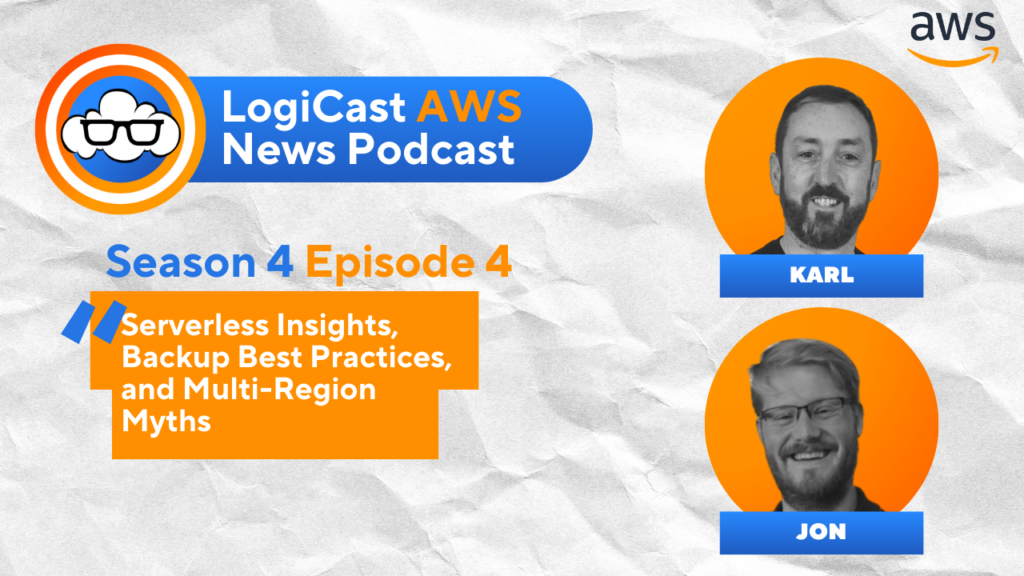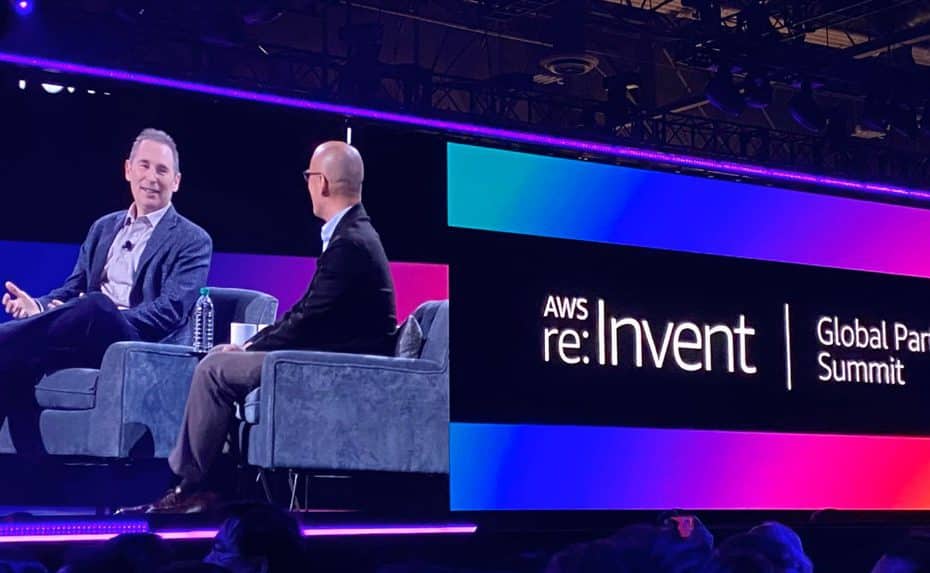Karl Robinson
January 10, 2020
Karl is CEO and Co-Founder of Logicata – he’s an AWS Community Builder in the Cloud Operations category, and AWS Certified to Solutions Architect Professional level. Knowledgeable, informal, and approachable, Karl has founded, grown, and sold internet and cloud-hosting companies.
**This post was updated in March 2025**
EC2 is short for Elastic Compute Cloud. It is Amazon Web Services IaaS (Infrastructure as a Service) offering that enables developers to gain easy access to compute resources in the AWS cloud.
AWS now offers over 850 EC2 instance types optimised to fit different use cases, a significant increase from the 275 mentioned in my original 2020 post. Each EC2 instance has a set configuration of CPU, RAM, storage type and network performance. The instances are grouped into ‘instance types’ which are optimised for different compute workloads. As there are so many options, it’s still wise to monitor your EC2 workloads for performance and cost savings. I include an introduction to CloudWatch Metrics, considerations for AWS Compute Optimizer, and AWS purchasing options at the end of this post.

How to remember instance types – Fight Dr McPixie!
Ryan Kroonenburg of a Cloud Guru, the AWS training and certification provider acquired by Pluralsight in 2021, had an amusing mnemonic in his AWS training programs to help learners remember the different instance families – FIGHT DR McPIXIE!

With the advent of new instance types back in 2020, the mnemonic was expanded – Dr McPixie became Australian with the addition of A and U instances! In fact, the letters are FIGHT DR MCPXZ AU – but it’s close enough and easy to remember. Here’s what the letters stand for:
- F – FPGA
- I – IOPS
- G – Graphics
- H – High disk throughput
- T – cheap general purpose
- D – Density
- R – RAM
- M – Main choice general purpose apps
- C – Compute
- P – Picture (graphics)
- X – eXtreme memory
- Z – Z-factor. Extreme memory and CPU
- A – ARM based instances
- U – Bare metal
There are now even more letters to remember that don’t fit into the mnemonic, but don’t worry, those are explained later in the post.

EC2 Instance Families
AWS categorize the instance families as follows:
- General Purpose
- Compute Optimized
- Memory Optimized
- Accelerated Computing
- Storage Optimized
- **HPC Optimized – NEW
Here’s how the letters from the mnemonic fit into the AWS instance families:
- General Purpose
- T – cheap general purpose
- M – Main choice general purpose apps
- Compute Optimized
- C – Compute
- Memory Optimized
- R – RAM
- X – eXtreme memory
- Z – Z-factor. Extreme memory and CPU
- Accelerated Computing
- P – Picture (graphics)
- G – Graphics
- F – FPGA
- Storage Optimized
- I – IOPS
- D – Density
- H – High disk throughput
Missing from A Cloud Guru’s original mnemonic were ‘High Memory’ and ‘Inf’ instance types as since 2020, the range of instance families and the options within them have significantly expanded. Notably, AWS Graviton-powered instances (Arm-based) have become increasingly prominent across several families.
Can we help manage your EC2 estate? Logicata monitors & patches for clients daily. We often reduce AWS costs too. Get in touch.
Anatomy of an EC2 instance name
Let’s take an example of an EC2 instance type and break down the name into it’s component parts:
- m6gd.medium
- m = instance family (general purpose)
- 6 = 6th generation of this instance type
- g = Graviton CPU (Could be A for AMD, I for Intel)
- d = local attached NVMe SSD
- medium = t-shirt size (how much CPU, RAM and Network throughput the instance has)
- The following letters which generally appear before the ‘.size’ in the EC2 instance type denote certain features:
- “n” for network-optimized
- “g” for GPU-accelerated
- “c” for compute-optimized
- “d” for data-intensive
Let’s summarise what each instance type is optimized for, and the instances that are available.
What are the different Instance Types?
Please note that where I have denoted something as new, it may not be that new in AWS terms, but it is new since the original 2020 version of this post.
General Purpose
T – cheap general-purpose instances are available as follows:
- T2 (7 configurations available) – Intel Xeon CPU, recommended for websites and webapps. They have a baseline level of CPU performance with the ability to burst above the baseline.
- T3 (7 configurations available) – Intel Xeon CPU, recommended for micro services, low latency interactive applications, small and medium databases.
- T3A (7 configurations available) – like T3 but AMD EPYC 7000 series CPU.
- T4g – NEW – powered by AWS Graviton2.
M – Main choice for general purpose apps:
- M4 (6 configurations available) – Intel Xeon Broadwell & Hasewell CPU, recommended for small & mid-size databases, data processing tasks requiring RAM, caching fleets or backend servers for SAP, Sharepoint or other clustered enterprise apps.
- M5 (18 configurations available) – Intel Xeon Platinum CPU, recommended for small & mid-size databases, data processing tasks requiring RAM, caching fleets or backend servers for SAP, Sharepoint or other clustered enterprise apps.
- M5a (16 configurations available) – AMD EPYC 7000 CPU, recommended for small & mid-size databases, data processing tasks requiring RAM, caching fleets or backend servers for SAP, Sharepoint or other clustered enterprise apps.
- M5n – (14 configurations available) – Intel Xeon Cascade Lake CPUs, recommended for Web & App servers, small and medium databases, cluster computing, gaming servers, caching fleets & other enterprise apps.
- **M5d NEW – Intel Xeon Platinum CPU
- **M5ad NEW – built on AMD EPYC 7000 CPUs, can benefit from local NVMe based SSDs
- **M5dn – NEW –
- **M5zn – NEW (7 Configurations available) –
- M6g (9 configurations available) – AWS Arm based Graviton CPUs, recommended for apps built on open source software – app servers, microservices, gaming etc.
- **M6gd NEW – (9 configurations available) – powered by AWS Graviton 2 with local NVMe-based SSDs.
- **M6i – NEW – (10 Configurations available) – 3rd Generation Intel Xeon Scalable processor
- **M6id – NEW – (10 Configurations available) – 3rd Generation Intel Xeon Scalable processor with local NVMe-based SSDs.
- **M6in – NEW – (10 Configurations available) – 3rd Generation Intel Xeon Scalable processors (Ice Lake)
- **M6idn – NEW – (10 Configurations available) – 3rd Generation Intel Xeon Scalable processors (Ice Lake) with local NVMe-based SSDs
- **M6a – NEW – (11 configurations available) – 3rd generation AMD EPYC processors
- **M7g NEW – (9 configuration options available) -powered by AWS Graviton3.
- **M7gd NEW – (9 configuration options available) powered by AWS Graviton 3 with local NVMe-based SSDs.
- **M7i NEW – (11 configuration options available) – powered by 4th Generation Intel Xeon Scalable processors.
- **M7a NEW – (12 configuration options available) powered by 4th Generation AMD EPYC processors.
- **M7i-flex NEW – (7 configuration options available), powered by 4th generation Intel Xeon Sapphire Rapids 8488C.
- **M8g NEW – (12 configuration options available) – powered by AWS Graviton 4.
- **M1 Mac NEW – (1 configuration option available) built on Apple M1 Mac mini.
- **M2 Pro Mac NEW – (1 configuration option available) built on Apple M2 Mac mini.
- **x86 based Mac NEW – (1 configuration option available) built on Apple X86 based Mac Mini.

Compute Optimized
Compute optimized instances are available in the following families:
- C4 – (5 configurations available) Intel Haswell CPUs, recommended for high-performance front-end fleets, web servers, batch processing, distributed analytics, high performance science and engineering apps and video encoding.
- C5 – (18 configurations available, including 2 bare metal options) – Intel Xeon Cascade Lake CPUs, recommended for high performance web servers, scientific modelling, batch processing, HPC, AI/ML, ad servers, multiplayer gaming and video encoding.
- C5n – (7 configuration options including one bare metal option) – Intel Xeon Platinum CPUs with AVX-512 instruction set, recommended for high performance web servers, scientific modelling, batch processing, HPC, AI/ML, ad servers, multiplayer gaming and video encoding.
- **C5d NEW – (9 configurations available) – Intel Xeon Platinum CPUs (Skylake SP or Cascade Lake) with local NVMe-based SSDs.
- **C5a NEW – (8 configurations available) – powered by 2nd Generation AMD EPYC processors.
**C5ad NEW – (8 configurations available) – powered by 2nd Generation AMD EPYC processors with local NVMe-based SSDs. - **C6g NEW – (9 configurations available) – powered by AWS Graviton2.
- **C6gd NEW – (9 configurations available) – powered by AWS Graviton2 with local NVMe-based SSDs.
- **C6gn NEW – (9 configurations available) – powered by AWS Graviton2.
- **C6i NEW – (10 configurations available)- powered by 3rd Generation Intel Xeon Scalable processors.
- **C6id NEW – (10 configurations available)- powered by 3rd Generation Intel Xeon Scalable processors with local NVMe-based SSDs.
- **C6in NEW – (10 configurations available)- powered by 3rd Generation Intel Xeon Scalable processors.
- **C6i-flex NEW – (7 configurations available) – powered by 3rd Generation Intel Xeon Scalable processors with burstable performance
- **C6a NEW – (12 configurations available) – powered by 3rd Generation AMD EPYC processors.
- **C7g NEW – (9 configurations available) – powered by AWS Graviton3.
- **C7gd NEW – (9 configurations available) – powered by AWS Graviton 3 with local NVMe-based SSDs.
- **C7gn NEW – (9 configurations available) – powered by AWS Graviton3.
- **C7i NEW – (11 configurations available)- powered by 4th Generation Intel Xeon Scalable processors.
- **C7i-flex NEW – (7 configurations available) – powered by 4th Generation Intel Xeon Scalable processors with burstable performance
- **C7a NEW – (12 configurations available) – powered by 4th Generation AMD EPYC processors.
- **C8g NEW – (12 configurations available) – powered by AWS Graviton4 processors.

Memory Optimized
R – RAM
- R4 – (6 configurations available), Intel Broadwell CPUs, recommended for high performance databases, data mining & analytics, in-memory databases, web scale in-memory caches, Hadoop, Spark clusters etc.
- R5 – (9 configurations available), Intel Platinum CPUs, recommended for high performance databases, real time big data analytics, mid-sized in memory databases.
- R5a – (8 configuration options available), AMD EPYC 7000 CPUs, recommended for high performance databases, real time big data analytics, mid-sized in memory databases.
- **R5ad NEW – (8 configuration options available), AMD EPYC 7000 CPUs with local NVMe SSDs, recommended for high performance databases, real time big data analytics, mid-sized in memory databases.
- R5n – (8 configuration options available), Intel Cascade Lake CPUs, recommended for high performance databases, real time big data analytics, mid-sized in memory databases.
- **R5d NEW (9 configurations available) – 1st or 2nd generation Intel Xeon Platinum 8000 series processor (Skylake-SP or Cascade Lake) with local NVMe SSD.
- **R5dn NEW (9 configurations available) – 1st or 2nd generation Intel Xeon Platinum 8000 series processor (Skylake-SP or Cascade Lake) with local NVMe SSD.
- **R5b NEW – (9 configurations available) – 2nd generation Intel Xeon Scalable Processors (Cascade Lake)
- **R6g NEW – powered by AWS Graviton2.
- **R6gd NEW – powered by AWS Graviton2 with local NVMe-based SSDs.
- **R6i NEW – (10 configurations available) – powered by 3rd Generation Intel Xeon Scalable processors.
- **R6id NEW – (10 configurations available) – powered by 3rd Generation Intel Xeon Scalable processors with local NVMe SSD.
- **R6in NEW – (10 configurations available) – powered by 3rd Generation Intel Xeon Scalable processors with accelerated network performance.
- **R6idn NEW – (10 configurations available) – powered by 3rd Generation Intel Xeon Scalable processors with local NVMe SSD and accelerated network performance.
- **R6a NEW – (11 configurations available) – powered by 3rd Generation AMD EPYC processors.
- **R7g NEW – (9 configurations available) – powered by AWS Graviton3.
- **R7gd NEW – (9 configurations available) – powered by AWS Graviton3 with local NVMe-based SSDs.
- **R7i NEW – (11 configurations available) – powered by 4th Generation Intel Xeon Scalable processors.
- **R7iz NEW – (10 configurations available) – powered by 4th Generation Intel Xeon Scalable processors.
- **R7a NEW – (12 configurations available) – powered by 4th Generation AMD EPYC processors.
- **R8g NEW – (12 configurations available) – powered by AWS Graviton4.
X – eXtreme Memory
- X1 – (2 configuration options available), Intel Haswell CPUs, recommended for SAP HANA, Apache Spark or Presto or High-Performance Computing (HPC) requirements.
- X1e – (6 configuration options available, higher RAM than X1) – recommended for SAP HANA, Apache Spark or Presto or High-Performance Computing (HPC) requirements
- **X2gd NEW – (9 configurations available)powered by AWS Graviton2.
- **X2idn NEW – (4 configurations available) – powered by AWS Graviton3 with local NVMe SSD and accelerated network performance.
- **X2iezn NEW – (4 configurations available) – powered by 2nd generation Intel Xeon Scalable processors.
- **X2iedn NEW – (8 configurations available)powered by 3rd generation Intel Xeon Scalable processors with local NVMe SSD and accelerated network performance.
- **X8g NEW – (12 configurations available) – powered by AWS Graviton4.
Z – Z Factor, Extreme Memory and CPU
- Z1d – (7 configuration options available) – Custom Intel Scalable CPU, recommended for electronic design automation and relational database workloads with high per core licensing costs. High Memory (5 bare metal options available) – Intel Skylake CPU, recommended for large enterprise databases including SAP HANA. Additionally, newer High Memory (U-1) instances designed for large in-memory databases are now available.

Accelerated Computing
P – Picture (graphics)
P – Picture (graphics) – recommended for machine learning, high performance databases, computational fluid dynamics, computational finance, seismic analysis, genomics etc.
- P2 – (3 configuration options available) – Intel Broadwell CPU, high performance NVIDIA GPUs.
- P3 – (4 configuration options available) – Intel Broadwell CPU, up to 8 NVIDIA high performance GPUs.
- **P3dn NEW – (2 configuration options available) – powered by NVIDIA A100 Tensor Core GPUs.
- **P4 NEW – (2 configuration options available) – powered by NVIDIA A100 Tensor Core GPUs.
- **P5 NEW. Inf – (3 configuration options available) – powered by NVIDIA H100 Tensor Core GPUs for Machine Learning Inference Applications
- **P5e NEW. Inf – (3 configuration options available) – powered by NVIDIA H200 Tensor Core GPUs for Machine Learning Inference Applications
- **P5en NEW. Inf – (3 configuration options available) – powered by NVIDIA H200 Tensor Core GPUs for Machine Learning Inference Applications
- Inf1 – (4 Configuration Options available) – Custom AWS Inferentia CPU, recommended for recommendation engines, forecasting, image and video analysis, text & document analysis, voice recognition, translating, transcribing and fraud detection.
- **Inf2 NEW – (4 configuration options available) – powered by AWS Inferentia2.
Inf – Machine Learning Inference Applications
- Inf1 – (4 Configuration Options available) – Custom AWS Inferentia CPU, recommended for recommendation engines, forecasting, image and video analysis, text & document analysis, voice recognition, translating, transcribing and fraud detection.
- **Inf2 NEW – (4 configuration options available) – powered by AWS Inferentia2.
G – Graphics
- G3 – (4 configuration options available) – Intel Broadwell CPUs, NVIDIA GPUs, recommended for 3D visualizations, graphics intensive remote workstations, application streaming, video encoding etc.
- G4 – (7 configuration options available including single and multiple GPU VMs and 1 bare metal option) – Intel Cascade Lake CPUs, NVIDIA GPUs, recommended for machine learning inference applications and game streaming.
- **G4ad NEW – (5 configuration options available) – AMD Radeon Pro V520 GPUs and 2nd generation AMD EPYC processors.
- **G4dn NEW – (7 configuration options available) – NVIDIA T4 GPUs and custom Intel Cascade Lake CPUs
- **G5 NEW – (6 configuration options available) – up to 8 NVIDIA A10G Tensor Core GPUs and second generation AMD EPYC processors.
- **G5g NEW – (8 configuration options available) – powered by AWS Graviton2 processors and feature NVIDIA T4G Tensor Core GPUs.
- **G6 NEW – (8 configuration options available) – powered by NVIDIA L4 Tensor Core GPUs for graphics-intensive and machine learning use cases.
- **G6e NEW – (8 configuration options available) – powered by NVIDIA L40S Tensor Core GPUs
F – FPGA
- F1 – (3 configuration options available) – Intel Broadwell CPUs, Xilinx FPGAs, recommended for genomics, financial analytics, real time video processing, big data search & analysis, and security.
- **F2 NEW – (3 configuration options available) – second-generation FPGA-powered instances.
- **Trn1 NEW – (3 configuration options available) – powered by AWS Trainium1, purpose-built for machine learning training.
- **Trn1n NEW – (3 configuration options available) – powered by AWS Trainium1, purpose-built for machine learning training.
- **Trn2 NEW – (2 configuration options available) – powered by AWS Trainium2, purpose-built for machine learning training.
- **DL1 NEW – (1 configuration option available) – powered by Gaudi accelerators from Habana Labs.
- **DL2q NEW – (1 configuration option available) – powered by Qualcomm AI 100 accelerators.
- **VT1 NEW – (3 configuration options available) – Powered by Xilinx U30 media accelerator cards to accelerate real time video transcoding.

Storage Optimized
I-IOPS
Recommended for NoSQL databases – Cassandra, Mongo, Redis, in memory databases, scale out transactional databases, Elasticsearch & analytics workloads.
- I3 – (7 coecommended for NoSQL databases – Cassandra, Mongo, Redis, in memory databases, scale out transactional databases, Elasticsearch & analytics workloads.
- I3 – (7 configuration options available, including 1 bare metal) – Intel Broadwell CPUs, Non-Volatile Memory Express SSD Storage.
- I3en – (8 Configuration options available, including 1 bare metal) – Intel Skylake CPUs, Non-Volatile Memory Express SSD Storage.
- **I4i NEW – powered by 3rd generation Intel Xeon Scalable processors.
- **I4g NEW – (6 configuration options available) – powered by AWS Graviton2 with local NVME storage using AWS Nitro SSDs
- **Im4gn NEW – (6 configuration options available) – powered by AWS Graviton2 with local NVME storage using AWS Nitro SSDs and enhanced network throughput.
- **Is4gen NEW – (6 configuration options available) – powered by AWS Graviton2 with local NVME storage using AWS Nitro SSDs and enhanced network throughput.
- **I7ie NEW – (9 configuration options available) – powered by 5th generation Intel Xeon Scalable processors with 3rd generation AWS Nitro SSDs.
- **I8g NEW – (9 configuration options available) – powered by AWS Graviton
D – Density
- D2 – (4 configuration options D2 – (4 configuration options available) – Inten Xeon CPU, up to 48TB of HDD based local storage. Recommended for MPP Data Warehousing, Map Reduce and Hadoop, distributed or network file systems, log or data processing applications. H – High disk throughput
**D3 NEW – (4 configuration options available) – 2nd Generation Intel Xeon Scalable (Cascade Lake), from 6 to 48 TB of local HDD storage.
**D3en NEW – (6 configuration options available) – 2nd Generation Intel Xeon Scalable (Cascade Lake), from 28 to 336 TB of local HDD storage .
H1 – (4 configuration options available) – Intel Xeon CPU, up to 16TB of HDD based local storage, recommended for Map Reduce workloads, Apache Kafka, big data workload clusters.
H- High Disk Throughput
- H1 – (4 configuration options available) – Intel Xeon CPU, up to 16TB of HDD based local storage, recommended for Map Reduce workloads, Apache Kafka, big data workload clusters.
HPC Optimized
The HPC Optimized category did not exist when the original post was written back in 2020. HPC Optimized instances aredesigned for compute-intensive high performance computing (HPC) workloads.
- **Hpc6id NEW – (1 configuration option available) – powered by 3rd Generation Intel Xeon Scalable processors.
- **Hpc6a NEW – (1 configuration option available) – powered by 3rd Gen AMD EPYC processors.
- **Hpc7g NEW – (3 configuration options available) – powered by Arm-based Graviton3E processors.
- **Hpc7a NEW – (4 configuration options available) – powered by 4th Gen AMD EPYC processors.

Choosing the Right AWS EC2 Instance
Wow, that’s a lot of options! Over 850 instance configurations, 6 high-level categories and 12 subcategories. So how do you go about selecting the right instance type for your workload?
AWS tells you what workloads each instance type is suitable for, but it’s up to you to evaluate the important performance metrics for your applications & workloads and map those to the appropriate instance family and specification.
The new AWS Graviton processors offer significant price/performance benefits over other chipsets for many workloads, so if your workloads are compatible you should seriously consider using Graviton CPUs where possible.
Once you’ve selected an instance type, you should also ensure that you continue to monitor your workloads running in AWS EC2, to ensure that you are still using the most appropriate instance type from both a performance and a cost management perspective.
AWS Compute Optimizer makes recommendations to help improve performance or save money – but AWS Compute Optimizer currently only makes recommendations for M, C, R, T, I, D, H, and X instance families, but not for G instance families. You also need to ‘opt in’ to Compute Optimizer – it is not on by default.

AWS Compute Optimizer analyses CloudWatch Metrics in order to make its recommendations:
- CPU Utilization
- RAM Utilization (requires a custom CloudWatch metric to be set up)
- Network In
- Network Out
- Local Disk I/O
CloudWatch by default polls at 5-minute intervals – you’ll need to enable detailed monitoring to monitor resources at 1 minute intervals, and you may incur additional charges for this.
There are also a range of 3rd party tools that have this functionality, some can even combine performance metrics from third party monitoring tools into the recommendations. Compute Optimizer is limited to AWS CloudWatch metrics which may be polling less frequently than third party tools.
You could also enlist the help of an AWS Partner or Managed Service Provider to help you with the ongoing optimization of your EC2 instances.
Still not sure which EC2 instance is right for you? Speak to a Logicata AWS Expert
Changing EC2 Instance Type
If you decide that you need to change instance type for performance or cost management reasons, you can simply resize it to another instance type as long as:
- Virtualization type is the same – PV (paravirtual) or HVM (Hardware virtual machine) – EC2 uses both virtualization types
- CPU Architecture is the same – limited support for 32 bit AMIs, Arm processors etc
- Network is compatible – newer instances need to be in a VPC, so EC2 classic instances can’t be resized to a newer instance type if not in a VPC
- Root Storage is an EBS volume – if not, you’ll need to migrate your application to the new instance type.
- Enhanced Networking Drivers are installed
- NVMe Drivers are installed
Check out this other post on How to Change or Upgrade an EC2 Instance Type

EC2 Instance Purchasing Options
As with all AWS services, there are several purchasing options for EC2 instances:
- On-Demand – hourly metered billing
- Standard Reserved Instance/Convertible Reserved Instance – 1 or 3 year commitment options, with discounts of up to 75% compared to On-Demand which vary by instance type and region
- All Up Front – one off payment
- Partial Up Front – 6 months up front with the balance on monthly payments
- No Up Front – discounted monthly rate
Standard RIs can change Availability Zone, instance size and networking type. If you need the flexibility to change instance family, operating system type or tenancy, you’ll need a Convertible RI.
- Scheduled Reserved Instances – available to launch within the time window you reserve – this enables you to match your capacity reservation to a predictable recurring schedule.
- Compute Savings Plans – a flexible pricing model launched in November 2019 that enables you to commit to a consistent amount of compute usage in $/hour or a 1 or 3 year term in return for a discount of up to 66%
- EC2 Instance Savings Plans – discounts of up to 72% in exchange for commitment to usage of individual instance families in a region, for example T2.Micro usage in EU (London)
- Spot Instances – enables you to bid whatever price you want for instance capacity – instances only run when your bid price is met.
- Dedicated Hosts – physically dedicated hosts to run EC2 instances, if you need to run per core or per socket software licenses.
- Dedicated Instances – single-tenant hardware for multiple EC2 instances, available on-demand.
- Capacity Reservations – reserve capacity for your instances in a single Availability Zone.
So, there you have it – everything you need to know about AWS EC2 instances, all in one place!





